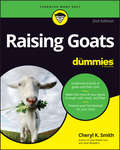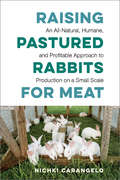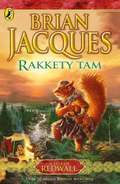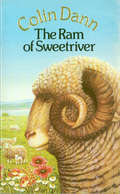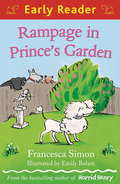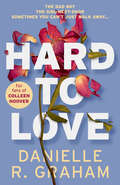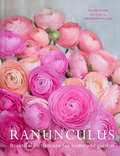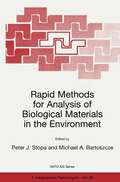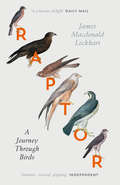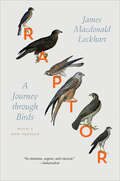- Table View
- List View
Raising Goats For Dummies
by Cheryl K. SmithNo buts: discover the addictive joy of raising goats Goats are amazing, multi-talented creatures that have been domesticated for over 10,000 years. As well as being a source of food, clothes, and milk, they’re wonderful companions: cute, intelligent, and playful—and often as friendly and attentive as dogs. In addition, they make endearing noises and—according to ancient Ethiopian legend—discovered coffee. So what’s holding you back? The new edition of Raising Goats For Dummies rebuts all your excuses, and shows you why having one—or, actually, a few—of these companionable ruminants (cud-chewing animals) in your life will bring you great joy, and, if you choose, unbeatable homemade milk and cheese—and possibly a cozy new sweater. A happy goat aficionado since 1998, Cheryl K. Smith takes you from the grassroots of raising your goat—choosing and buying the breed you want, building and maintaining goat-friendly housing—to more elevated terrain, including how to build your own milk stand, participate in online goat shows (it’s a thing!), and even monetize your goat. You’ll also learn the fundamentals of proper care to make sure your goats are fed, kept healthy, and bred in ways that ensure they have the happiest life you can provide. Study the history and breeds of goat, like the Nigerian Dwarf or Pygmy Live sustainably from and even profit from your goat Identify and alleviate common ailments Have fun raising the kids! Whether you’re researching buying a goat or learning on the hoof about the ones you have, this book has everything you need to see why getting your goat will bring years and years of joy.
Raising Goats For Dummies
by Cheryl K. SmithNo buts: discover the addictive joy of raising goats Goats are amazing, multi-talented creatures that have been domesticated for over 10,000 years. As well as being a source of food, clothes, and milk, they’re wonderful companions: cute, intelligent, and playful—and often as friendly and attentive as dogs. In addition, they make endearing noises and—according to ancient Ethiopian legend—discovered coffee. So what’s holding you back? The new edition of Raising Goats For Dummies rebuts all your excuses, and shows you why having one—or, actually, a few—of these companionable ruminants (cud-chewing animals) in your life will bring you great joy, and, if you choose, unbeatable homemade milk and cheese—and possibly a cozy new sweater. A happy goat aficionado since 1998, Cheryl K. Smith takes you from the grassroots of raising your goat—choosing and buying the breed you want, building and maintaining goat-friendly housing—to more elevated terrain, including how to build your own milk stand, participate in online goat shows (it’s a thing!), and even monetize your goat. You’ll also learn the fundamentals of proper care to make sure your goats are fed, kept healthy, and bred in ways that ensure they have the happiest life you can provide. Study the history and breeds of goat, like the Nigerian Dwarf or Pygmy Live sustainably from and even profit from your goat Identify and alleviate common ailments Have fun raising the kids! Whether you’re researching buying a goat or learning on the hoof about the ones you have, this book has everything you need to see why getting your goat will bring years and years of joy.
Raising Hare: The heart-warming true story of an unlikely friendship
by Chloe Dalton'A beautiful book' - ANGELINA JOLIE'A glorious book – for its warmth, its precision, its joy' - KATHERINE RUNDELL'I will be recommending this to everyone' - MATT HAIG__Imagine you could hold a baby hare and bottle-feed it. Imagine that it lived under your roof and lolloped around your bedroom at night, drumming on the duvet cover when it wanted your attention. Imagine that, over two years later, it still ran in from the fields when you called it and snoozed in your house for hours on end. This happened to me.When lockdown led busy professional Chloe to leave the city and return to the countryside of her childhood, she never expected to find herself custodian of a newly born hare. Yet when she finds the creature, endangered, alone and no bigger than her palm, she is compelled to give it a chance at survival.Raising Hare chronicles their journey together and the challenges of caring for the leveret and preparing for its return to the wild. We witness an extraordinary relationship between human and animal, rekindling our sense of awe towards nature and wildlife. This improbable bond of trust serves to remind us that the most remarkable experiences, inspiring the most hope, often arise when we least expect them.
Raising Pastured Rabbits for Meat: An All-Natural, Humane, and Profitable Approach to Production on a Small Scale
by Nichki CarangeloAn accessible, practical resource for pasture-based rabbit production-complete with rabbit husbandry basics, enterprise budgets, and guidelines for growing, processing and selling rabbits commercially. In recent years, there has been talk in the food world that rabbits make more sense than chicken. In a country with a $41 billion broiler chicken industry, this might seem like a pretty bold statement, but it’s hardly unsubstantiated. And yet while media has been abuzz about the supposed super protein, very few farmers are stepping up to meet the rapidly increasing interest in sustainably raised rabbit meat. This is partly due to the lack of available resources in the field of rabbit husbandry. Raising Pastured Rabbits for Meat is the first book to address the growing trend of ecological rabbit husbandry for the beginning to market-scale farmer. Inspired by Daniel Salatin, who has long been considered the pioneer in integrated rabbit farming, Nichki Carangelo proves that a viable pasture-based rabbitry is not only possible and user-friendly, it’s also profitable. In Carangelo’s approach, happy, healthy rabbits are seasonally raised outside on pasture, using a pasture and wire hybrid system that promotes natural behaviors and a diverse diet, while effectively managing the associated risks. Raising Pastured Rabbits for Meat offers valuable information on how farmers can build their own rabbit enterprise from scratch and includes tips on breed selection, breeding techniques, nutrition guidelines, record keeping tools, slaughtering and butchering instructions, marketing advice, and enterprise guides to help farmers plan for profitability. This is an essential guide for anyone interested in integrating rabbits onto a diversified farm or homestead.
Rakkety Tam (Redwall)
by Brian JacquesThe seventeenth book in the beloved, bestselling Redwall saga - soon to be a major Netflix movie!Rakkety Tam MacBurl is a brave border warrior who has travelled south in search of adventure. But when his army is attacked by an evil flesh-eating band, adventure finds him. Gulo the Savage, wolverine, flesh-eater and brutal killer, has come to Mossflower in search of his brother - who stole the mystical stone that will make one of them king of the lands of ice and snow. Any beast who gets in Gulo's way is dead meat. And he's heading for the peaceful Redwall Abbey - unless Rakkety Tam can stop him.
The Ram Of Sweetriver
by Colin DannThe Sweetriver flock has survived the terrible storm which destroyed their valey. But can they survive the long, hungry journey to find new pastures? Jacob, the ram of Sweetriver, must use every ounce of his courage to fend off danger and keep the flock together. But his enemies are not only outside the flock . . .
Rampage in Prince's Garden (Early Reader)
by Francesca SimonEarly Readers are stepping stones from picture books to reading books. A blue Early Reader is perfect for sharing and reading together. A red Early Reader is the next step on your reading journey.Prince the poodle is away, leaving his secret garden free for the rest of the Buffin Street Gang to explore. After all, he'll never even know they've been there . . . will he?
Ranaviruses: Lethal Pathogens of Ectothermic Vertebrates
by Matthew J. Gray V. Gregory ChincharThis is the first book on ranaviruses. Ranaviruses are double-stranded DNA viruses that cause hemorrhagic disease in amphibians, reptiles, and fish. They have caused mass die-offs of ectothermic vertebrates in wild and captive populations around the globe. There is evidence that this pathogen is emerging and responsible for population declines in certain locations. Considering that amphibians and freshwater turtles are suitable hosts and the most imperiled vertebrate taxa in the world, ranaviruses can have significant impacts on biodiversity and ecosystem function. Additionally, many fish that are raised in aquaculture facilities and traded internationally are suitable hosts; thus, the potential economic impact of ranaviruses is significant. Ranaviruses also serve as a model for replication and gene function of large double-stranded DNA viruses. There is an urgent need to assemble the contemporary information on ranaviruses and provide guidance on how to assess their threats in populations. Through the Global Ranavirus Consortium, 24 experts from six countries were organize to write this volume, the first book on ranaviruses. The book begins with a discussion on the global extent of ranaviruses, case histories of infection and disease in ectothermic vertebrates, and current phylogeny. Basic principles of ranavirus ecology and evolution are covered next, with a focus on host-pathogen interactions and how the virus emerges in its environment. There are two chapters that will discuss the molecular biology of ranaviruses, host response to infection, and the genes responsible for immune system evasion. One chapter establishes standards for testing for infection and diagnosing ranaviral disease. The book ends by providing guidance on how to design ranavirus surveillance studies and analyze data to determine risk, and discussing the role of the Global Ranavirus Consortium in organizing research and outreach activities.
Ranaviruses: Emerging Pathogens of Ectothermic Vertebrates
by Matthew J. Gray V. Gregory ChincharThis is a open access book. Ranaviruses, double-stranded DNA viruses (family Iridoviridae) that cause systemic, life-threatening disease in a variety of amphibians, reptiles and fish, have contributed to mass die-offs of both wild and captive populations around the globe. These viruses are emerging and increasingly responsible for population declines of ectothermic vertebrates. Because amphibians, reptiles, and freshwater turtles are suitable hosts and among the most imperiled vertebrate taxa in the world, ranaviruses can have significant impacts on biodiversity and ecosystem function. Additionally, many fish that are raised in aquaculture facilities and traded internationally are suitable hosts; thus, the potential economic impact of ranaviruses is significant. Ranaviruses also serve as a model for understanding viral replication and gene function among large double-stranded DNA viruses, e.g., poxviruses, asfarvirus, and ascoviruses. Lastly, study of the host immune response to ranaviral disease and the identification of viral immune evasion genes that negatively regulate host immune functions provide insight into which specific immune elements are most important in protecting host species against severe disease. The effort to produce a 2nd edition of our earlier work grew out of a recent meeting (1st Global Amphibian and Reptile Disease Conference) held in August 2022. Given the continued research in ranaviruses and ranaviral disease since the first edition, this new book updates the latest information on ranaviruses and provides guidance on how to monitor and manage ranaviruses in cold-blooded vertebrate populations.
Rangeland Wildlife Ecology and Conservation
by Lance B. McNew David K. Dahlgren Jeffrey L. BeckThis open access book reviews the importance of ecological functioning within rangelands considering the complex inter-relationships of production agriculture, ecosystem services, biodiversity, and wildlife habitat. More than half of all lands worldwide, and up to 70% of the western USA, are classified as rangelands—uncultivated lands that often support grazing by domestic livestock. The rangelands of North America provide a vast array of goods and services, including significant economic benefit to local communities, while providing critical habitat for hundreds of species of fish and wildlife. This book provides compendium of recent data and synthesis from more than 100 experts in wildlife and rangeland ecology in Western North America. It provides a current and in-depth synthesis of knowledge related to wildlife ecology in rangeland ecosystems, and the tools used to manage them, to serve current and future wildlife biologists and rangeland managers in the working landscapes of the West. The book also identifies information gaps and serves as a jumping-off point for future research of wildlife in rangeland ecosystems. While the content focuses on wildlife ecology and management in rangelands of Western North America, the material has important implications for rangeland ecosystems worldwide.
Ranunculus: Beautiful Buttercups For Home And Garden
by Naomi SladeRanunculus offers advice on how to care for and propagate these colourful cultivated members of the buttercup family. Naomi Slade explores a wide range of ranunculus species and cultivars, all beautifully photographed by Georgianna Lane in their technicolour glory from palest pink to deep burgundy via white, orange, red and yellow.
Rapid Detection of Infectious Agents (Infectious Agents and Pathogenesis)
by Steven Specter Mauro Bendinelli Herman FriedmanBusy clinicians and health practitioners recognize the importance of speedy detection of pathogens to impede the further spread of infection, and to ensure their patients' rapid and complete recovery. This reader-friendly reference is a unique collection of the newest and most effective diagnostic techniques currently in use in clinical and research laboratories. Instructive commentary regarding the application of these often complex methods is provided. This essential text aids readers in selecting the most efficient method, finding the necessary resources, and avoiding the most common pitfalls in implementation.
Rapid Diagnosis of Mycoplasmas (F.E.M.S. Symposium Series #62)
by Itzahak Kahane Amiram AdoniThis compendium is the result of the FEMS Workshop on "Rapid Diagnosis of Mycoplasmas" which I organized and which took place in Jerusalem, Israel, August 11-23, 1991. The first week's sessions were held at a resort on the outskirts of Jerusalem and consisted of lectures and discussions. This part was modelled along the lines of the Gordon Conference in the USA, i.e., in an intimate atmo sphere in which everyone could mix and exchange ideas, and was very benefi cial. About 100 scientists from around the world attended the first week. Dur ing the first week, the biology, molecular biology and pathophysiology of myco plasmas, as well as all the main diagnostic methods were covered, including both conventional and the newer technologies. The session on mycoplasmas in the human urogenital tracts was held in conjunction with the Israel Society for the Study and Prevention of Sexually Transmitted Disease. The second week was a laboratory session and was held at the Hebrew University-Hadassah Medical School campus in Ein Karem, Jerusalem. All ex periments were conducted by eminent specialists in their field. The lab session had 36 participants from 19 countries who used the most modern techniques for the diagnosis of mycoplasmas in medicine, veterinary medicine and agri culture. The efficacy of several commercial kits were also tested at this time. I want to again thank everyone who helped and supported this work shop, as well as the authors of the various chapters.
Rapid Interpretation of Heart and Lung Sounds: A Guide to Cardiac and Respiratory Auscultation in Dogs and Cats
by Bruce W. Keene Francis W. K. Smith Larry P. Tilley Bernie HansenComposed of a website and a companion book, this package demonstrates how to do accurate clinical evaluations of the heart and lungs in the examining room. The website offers step-by-step instructions on how to identify, interpret, and differentiate heart and lung sounds in dogs and cats. Made by using a heart sound simulator as well as recordings from patients, the website also covers heart murmurs and arrhythmias.The book expands on the website content and offers clear, concise illustrations of electrocardiograms (ECGs) and polarcardiograms (PCGs). It also includes pretests and post-tests to ensure thorough understanding of the material, as well as content on properties of sound, the stethoscope, and keys to successful auscultation. - Heart sound simulator allows you to focus on the heart sounds without the distraction of respiratory sounds or artifacts of hair rubbing against the stethoscope. - Wide variety of heart and lung sounds provides you with real-life cases that are as close to clinical practice as possible. - Pretests may be taken prior to reviewing the book and website to measure how much you already know. - Posttests help determine when the material has been mastered and direct the user to remediation in areas where additional study is needed. - Inclusion of clinically-relevant conditions makes it easy for you to apply this information to day-to-day practice. - Key points called out within the text alert you to potential problems, variations on techniques, and other treatment considerations. Lung sounds added Many more heart sounds Section on murmurs and arrhythmia expended Intros for each sound on the companion website have been expanded to provide more information
Rapid Methods for Analysis of Biological Materials in the Environment (NATO Science Partnership Subseries: 1 #30)
by Peter J. Stopa Michael A. BartoszczeContrary to common belief, infectious diseases are not as well under control as we would like. We are now at a crossroads regarding the impact of the environment on infectious diseases. Renewed interest in biological weapons and the emergence of new pathogens, coupled with a better understanding of the impact of infectious agents on other conventional diseases, has led us to realise that we can no longer remain complacent about the impact of infectious agents on human, animal and crop health. The present book first discusses current and emerging military and civilian policies on the environment. In addition, the impact of environmental biology on the future of space exploration is discussed, especially in reference to the Mars mission. There follows a discussion of the state of bacteria in the environment, with a presentation of current and emerging techniques of microbial investigation. Finally, two case studies are presented on the impact of these techniques on both political and environmental problems.
Rapid Review of ECG Interpretation in Small Animal Practice
by Mark A Oyama Marc S. Kraus Anna R GelzerThe standard electrocardiogram (ECG) is an indispensable, safe, and inexpensive test to assess dogs and cats with heart disease. This bestselling user-friendly book discusses the principles of electrocardiography, then systematically explores the evaluation of the ECG, including determination of heart rate, measurement of intervals, derivation of mean electrical axis, and criteria for atrial/ventricular enlargement or hypertrophy. At the core of this book is an extensive series of ECG cases for the reader to work through: practice makes perfect. New to this edition: Instructions on how to obtain an ECG A new chapter on the treatment of the most common clinically important ECG arrhythmias A second new chapter on 24-hour ECG (Holter) monitoring A handy one-page reference guide of important ECG values and diagrams, which can be downloaded from the book's webpage for easy reference 15 new ECG cases have been added to the original 46 cases, with a selection of advanced cases geared toward readers craving more challenging topics such as electrical cardioversion and pacemaker function. This updated edition will further aid veterinarians in their quest to better interpret the ECG. It provides information in an appealing, accessible, and easy to use format that fits with the busy lives of veterinary practitioners.
Rapid Review of ECG Interpretation in Small Animal Practice
by Mark A Oyama Marc S. Kraus Anna R GelzerThe standard electrocardiogram (ECG) is an indispensable, safe, and inexpensive test to assess dogs and cats with heart disease. This bestselling user-friendly book discusses the principles of electrocardiography, then systematically explores the evaluation of the ECG, including determination of heart rate, measurement of intervals, derivation of mean electrical axis, and criteria for atrial/ventricular enlargement or hypertrophy. At the core of this book is an extensive series of ECG cases for the reader to work through: practice makes perfect. New to this edition: Instructions on how to obtain an ECG A new chapter on the treatment of the most common clinically important ECG arrhythmias A second new chapter on 24-hour ECG (Holter) monitoring A handy one-page reference guide of important ECG values and diagrams, which can be downloaded from the book's webpage for easy reference 15 new ECG cases have been added to the original 46 cases, with a selection of advanced cases geared toward readers craving more challenging topics such as electrical cardioversion and pacemaker function. This updated edition will further aid veterinarians in their quest to better interpret the ECG. It provides information in an appealing, accessible, and easy to use format that fits with the busy lives of veterinary practitioners.
Rapid Review of Exotic Animal Medicine and Husbandry: Pet Mammals, Birds, Reptiles, Amphibians and Fish
by Karen Rosenthal Neil Forbes Fredric Frye Gregory LewbartFour authors of international renown have combined their practical and instructional skills to provide this focused yet wide-ranging review. The book is divided into four sections-small mammals, birds, reptiles/amphibians, ornamental fish-and consists of an introduction to the essential aspects of medicine and husbandry of each group of animals, 40
Raptor: A Journey Through Birds
by James Macdonald LockhartWinner of The Royal Society of Literature Jerwood Award for Non-Fiction in 2011 and the Authors' Foundation Roger Deakin Award in 2011 A stunning debut in the tradition of Robert Macfarlane and Helen Macdonald
Raptor: A Journey through Birds
by James Macdonald LockhartFrom the merlin to the golden eagle, the goshawk to the honey buzzard, James Macdonald Lockhart’s stunning debut is a quest of beak, talon, wing, and sky. On its surface, Raptor is a journey across the British Isles in search of fifteen species of birds of prey, but as Lockhart seeks out these elusive predators, his quest becomes so much more: an incomparably elegant elegy on the beauty of the British landscape and, through the birds, a journey toward understanding an awesome power at the heart of the natural world—a power that is majestic and frightening in its strength, but also fragile. Taking as his guide the nineteenth-century Scottish naturalist and artist William MacGillivray, Lockhart loosely follows the historical trail forged by MacGillivray as he ventured from Aberdeen to London filling his pockets with plants and writing and illustrating the canonical A History of British Birds. Linking his journey to that of his muse, Lockhart shares his own encounters with raptors ranging from the scarce osprey to the successfully reintroduced red kite, a species once protected by medieval royal statute, revealing with poetic immediacy the extraordinary behaviors of these birds and the extreme environments they call home. Creatures both worshipped and reviled, raptors have a talon-hold on the human heart and imagination. With his book, Lockhart unravels these complicated ties in a work by turns reverent and euphoric—an interweaving of history, travel, and nature writing at its best. A hymn to wanderers, to the land and to the sky, and especially to the birds, Raptor soars.
Raptor: A Journey through Birds
by James Macdonald LockhartFrom the merlin to the golden eagle, the goshawk to the honey buzzard, James Macdonald Lockhart’s stunning debut is a quest of beak, talon, wing, and sky. On its surface, Raptor is a journey across the British Isles in search of fifteen species of birds of prey, but as Lockhart seeks out these elusive predators, his quest becomes so much more: an incomparably elegant elegy on the beauty of the British landscape and, through the birds, a journey toward understanding an awesome power at the heart of the natural world—a power that is majestic and frightening in its strength, but also fragile. Taking as his guide the nineteenth-century Scottish naturalist and artist William MacGillivray, Lockhart loosely follows the historical trail forged by MacGillivray as he ventured from Aberdeen to London filling his pockets with plants and writing and illustrating the canonical A History of British Birds. Linking his journey to that of his muse, Lockhart shares his own encounters with raptors ranging from the scarce osprey to the successfully reintroduced red kite, a species once protected by medieval royal statute, revealing with poetic immediacy the extraordinary behaviors of these birds and the extreme environments they call home. Creatures both worshipped and reviled, raptors have a talon-hold on the human heart and imagination. With his book, Lockhart unravels these complicated ties in a work by turns reverent and euphoric—an interweaving of history, travel, and nature writing at its best. A hymn to wanderers, to the land and to the sky, and especially to the birds, Raptor soars.
Raptor: A Journey through Birds
by James Macdonald LockhartFrom the merlin to the golden eagle, the goshawk to the honey buzzard, James Macdonald Lockhart’s stunning debut is a quest of beak, talon, wing, and sky. On its surface, Raptor is a journey across the British Isles in search of fifteen species of birds of prey, but as Lockhart seeks out these elusive predators, his quest becomes so much more: an incomparably elegant elegy on the beauty of the British landscape and, through the birds, a journey toward understanding an awesome power at the heart of the natural world—a power that is majestic and frightening in its strength, but also fragile. Taking as his guide the nineteenth-century Scottish naturalist and artist William MacGillivray, Lockhart loosely follows the historical trail forged by MacGillivray as he ventured from Aberdeen to London filling his pockets with plants and writing and illustrating the canonical A History of British Birds. Linking his journey to that of his muse, Lockhart shares his own encounters with raptors ranging from the scarce osprey to the successfully reintroduced red kite, a species once protected by medieval royal statute, revealing with poetic immediacy the extraordinary behaviors of these birds and the extreme environments they call home. Creatures both worshipped and reviled, raptors have a talon-hold on the human heart and imagination. With his book, Lockhart unravels these complicated ties in a work by turns reverent and euphoric—an interweaving of history, travel, and nature writing at its best. A hymn to wanderers, to the land and to the sky, and especially to the birds, Raptor soars.
Raptor: A Journey through Birds
by James Macdonald LockhartFrom the merlin to the golden eagle, the goshawk to the honey buzzard, James Macdonald Lockhart’s stunning debut is a quest of beak, talon, wing, and sky. On its surface, Raptor is a journey across the British Isles in search of fifteen species of birds of prey, but as Lockhart seeks out these elusive predators, his quest becomes so much more: an incomparably elegant elegy on the beauty of the British landscape and, through the birds, a journey toward understanding an awesome power at the heart of the natural world—a power that is majestic and frightening in its strength, but also fragile. Taking as his guide the nineteenth-century Scottish naturalist and artist William MacGillivray, Lockhart loosely follows the historical trail forged by MacGillivray as he ventured from Aberdeen to London filling his pockets with plants and writing and illustrating the canonical A History of British Birds. Linking his journey to that of his muse, Lockhart shares his own encounters with raptors ranging from the scarce osprey to the successfully reintroduced red kite, a species once protected by medieval royal statute, revealing with poetic immediacy the extraordinary behaviors of these birds and the extreme environments they call home. Creatures both worshipped and reviled, raptors have a talon-hold on the human heart and imagination. With his book, Lockhart unravels these complicated ties in a work by turns reverent and euphoric—an interweaving of history, travel, and nature writing at its best. A hymn to wanderers, to the land and to the sky, and especially to the birds, Raptor soars.
Raptor Medicine, Surgery, and Rehabilitation
by Dr David ScottThis book is "arranged in a very useful manner and has great information for people of all experience levels. I'm hoping it becomes a staple for all teaching hospitals." Dr Dave McRuer, Director of Veterinary Services, Wildlife Center of Virginia, USA Comprehensive, intensely practical, and extensively illustrated, this unique book consolidates years of practical knowledge of dealing with injured birds of prey. Written by a practicing veterinarian, it: concisely covers helpful, day-to-day advice through hints, tips and clinical insights; provides an emphasis on practical procedures; and includes numerous illustrations for easy recognition of symptoms and replication of techniques. Outlining everything from handling and the intake examination through to practical procedures and the treatment of a comprehensive range of conditions and injuries, the book also advises readers on housing, rehabilitation and eventual release. Also including numerous rapid reference charts, this book is the one text that any avian or general veterinarian needs by the bench for the treatment of raptors and birds of prey.
